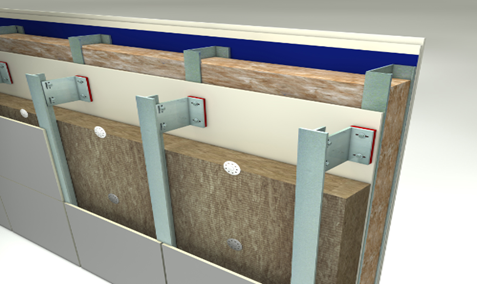The evolution of the glazing industry has led to an expanded scope of work performed by the glaziers to include other façade finishes or assemblies. Beyond economies of scale, a major reason for this development is to have fewer subcontractors involved in the exterior systems and simplified responsibility for the performance of the systems.
A variety of façade finishes applied to weather barrier support systems known as rainscreen walls have proven to be an economical long-lasting enclosure solution, and is the subject of this Technical Bulletin.
The term rainscreen wall typically defines an entire solid wall assembly designed with products and details that create either an open joint system or a pressure-equalized ventilated system. The rainscreen components are engineered to function as a complete system, inclusive of the support wall, the air-and water-resistive barrier, a type of channel/clip arrangement used to fasten the rainscreen veneer, the air gap, flashings and sealants. Further, energy efficiency can be enhanced through placement of continuous exterior insulation and the use of thermally broken components that reduce thermal bridging.

One of the most important aspects of building enclosure durability is moisture control. Managing water, either as vapor or liquid, is a critical design goal. A typical rainscreen is designed to shed water, thereby limiting the amount of water that could potentially come into contact with the primary building envelope’s moisture barrier. Drained walls are the most popular assemblies in that they contain an air space behind the cladding, allowing the passage of bulk water to the exterior. Ventilation provides enhanced capacity to dry and moderate humidity within the cavity.
The assigned scope of work varies by project, as it is not uncommon for support walls and sheathing, air-water resistive barrier and insulation to be by a separate subcontractor. If not, glazing subcontractors could have all or part of this scope.
- Air-water resistant barriers (AWB). The barrier products are typically fluid-applied membranes or peel-and-stick membranes, as specified by the architects. Consideration in the selection of these materials include building code compliance, long-term UV exposure, weather resistance, primer-less applications, warranty periods and warranty conditions. Flashings and weather seals are required to complete the primary barrier.
- Engineered sub-framing. These systems support the outboard cladding while maintaining the air gap between the cladding and the primary wall. These supports can be made of aluminum, steel, or other suitable materials, and are available in design enhancements that limit heat or cold thermal transfer.
- Ventilation and drainage cavity. The air gap or cavity between the outer cladding and the structural wall is an essential component of the rainscreen system. It provides a buffer zone for moisture dissipation, thermal insulation, and ventilation.
- Insulation material is installed within the air cavity to enhance thermal performance and reduce energy consumption. Rigid and semi-rigid mineral wool products are typically specified for these conditions.
- Exterior cladding. The cladding is available in a variety of different materials, such as metal panel, fiber cement, high-pressure laminate, terracotta, or natural stone. Each of these are available in a wide range of textures and colors. Each material has its own aesthetic, performance characteristics and warranties.
Performance not only includes the weatherability of the assembly, but must consider the ability of the systems to accommodate building movement and movement relative to other façade materials, such as:
- Slab live loads, as temporary loads that are applied to the floor structure on and off over the life of the building.
- Lateral interstory drift as the reaction of the structure to wind loads or a seismic event, with floors move in opposing directions.
- Both of these conditions require the air-water barrier detailing that allows for the movement while maintaining its integrity. A horizontal drift line of sufficient size established early in the façade coordination can typically address these conditions but may not solve movement issues between adjacent systems. Should these other systems move in conflict with the rainscreen wall, then the use of crush zone detailing may be required.
Understanding the rainscreen system fundamentals may provide the opportunity for incorporating this scope of work in your next project. As always, proper evaluation of the system applications and their ability to comply with performance requirements is essential to having a successful project.
